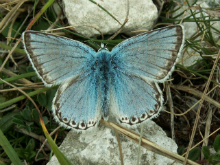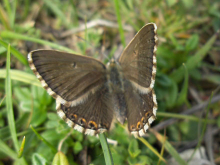
| Butterfly Conservation |
 |
| Hertfordshire & Middlesex Branch |
 |
|
|||
| Saving butterflies, moths and our environment | ||||


Chalkhill BlueLysandra coridonCommon at chalk sites Distribution and Status The Chalkhill Blue frequents chalk grasslands as the name suggests in north and west Hertfordshire. By the 1980s the only known significant colony was at Therfield Heath but even there it was just surviving. However, with conservation efforts involving selective grazing at suitable sites across Hertfordshire, the butterfly has recovered well with the best colonies at Therfield Heath and Hexton Chalk Pit but it can also be found at Telegraph Hill, Aldbury Nowers and Wilbury Hill near Letchworth. The high abundance in 2013 meant some dispersal took place among male specimens where they were discovered miles away from the chalk Habitat Requirements Chalk grasslands especially on south-facing slopes Larval Foodplants Horseshoe Vetch Hippocrepis comosa Adult Food Sources Wild Marjoram Origanum vulgare, Dung, Field Scabious Knautia arvensis, Common Knapweed Centaura nigra Behaviour/Observation notes It is a conspicuous butterfly with its milky-blue appearance. During spells of sunshine it flies rapidly just above the ground in between basking and feeding. In dull weather or during early morning or evening it will often bask or roost on tall vegetation affording good photographic opportunities Life History The Chalkhill Blue produces one generation a year with adults starting to emerge in July and peaking around the end of the month into the first week of August. Eggs are laid singly on Horsehoe Vetch H. comosa stems or surrounding vegetation. Eggs hatch in spring in the following year. Secretions from the larvae attract the attention of ants which provide some protection from predators. It is thought that pupae are often buried by the ants in the earth Further information
UK distribution map |
Copyright Butterfly Conservation © 2019 Hertfordshire & Middlesex Branch
Privacy and Copyright Statement and Cookie Policy Statement
Butterfly Conservation
Company limited by guarantee, registered in England (2206468)
Registered Office: Manor Yard, East Lulworth, Wareham, Dorset, BH20 5QP. Tel: 01929 400 209
Charity registered in England & Wales (254937) and in Scotland (SCO39268). VAT No. GB 991 2771 89